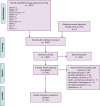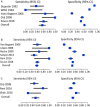Diagnostic accuracy of the partograph alert and action lines to predict adverse birth outcomes: a systematic review
- PMID: 31334912
- PMCID: PMC6899985
- DOI: 10.1111/1471-0528.15884
Diagnostic accuracy of the partograph alert and action lines to predict adverse birth outcomes: a systematic review
Abstract
Background: There are questions about the use of the 'one-centimetre per hour rule' as a valid benchmark for assessing the adequacy of labour progress.
Objectives: To determine the accuracy of the alert (1-cm/hour) and action lines of the cervicograph in the partograph to predict adverse birth outcomes among women in first stage of labour.
Search strategy: PubMed, EMBASE, CINAHL, POPLINE, Global Health Library, and reference lists of eligible studies.
Selection criteria: Observational studies and other study designs reporting data on the correlation between the alert line status of women in labour and the occurrence of adverse birth outcomes.
Data collection and analysis: Two reviewers at a time independently identified eligible studies and independently abstracted data including population characteristics and maternal and perinatal outcomes.
Main results: Thirteen studies in which 20 471 women participated were included in the review. The percentage of women crossing the alert line varied from 8 to 76% for all maternal or perinatal outcomes. No study showed a robust diagnostic test accuracy profile for any of the selected outcomes.
Conclusions: This systematic review does not support the use of the cervical dilatation over time (at a threshold of 1 cm/h during active first stage) to identify women at risk of adverse birth outcomes.
Tweetable abstract: Alert line of partograph does not identify women at risk of adverse birth outcomes.
Keywords: Alert line; childbirth; diagnostic accuracy; partograph.
© 2019 World Health Organization; licensed by John Wiley & Sons Ltd on behalf of Royal College of Obstetricians and Gynaecologists.
Figures


Comment in
-
The partogram - evidence-based medicine is personal opinion based on fact.BJOG. 2019 Dec;126(13):1534. doi: 10.1111/1471-0528.15911. Epub 2019 Oct 15. BJOG. 2019. PMID: 31446679 No abstract available.
-
'Revisiting the House of Horne': Redux!BJOG. 2019 Dec;126(13):1535. doi: 10.1111/1471-0528.15943. Epub 2019 Oct 10. BJOG. 2019. PMID: 31529616 No abstract available.
References
-
- National Institute for Health and Clinical Excellence . Intrapartum care for healthy women and babies. 2014 [https://www.nice.org.uk/guidance/cg190]. Accessed 12 February 2019. - PubMed
-
- Lawn JE, Kinney M, Lee AC, Chopra M, Donnay F, Paul VK, et al. Reducing intrapartum‐related deaths and disability: can the health system deliver? Int J Gynaecol Obstet 2009;107(Suppl. 1):S123–40, s40‐2. - PubMed
-
- Bhutta ZA, Das JK, Bahl R, Lawn JE, Salam RA, Paul VK, et al. Can available interventions end preventable deaths in mothers, newborn babies, and stillbirths, and at what cost? Lancet 2014;384:347–70. - PubMed
Publication types
MeSH terms
Grants and funding
- 001/WHO_/World Health Organization/International
- Department of Reproductive Health and Research/International
- United States Agency for International Development (USAID)/International
- UNDP/UNFPA/UNICEF/WHO/World Bank Special Programme of Research, Development and Research Training in Human Reproduction (HRP)/International
LinkOut - more resources
Full Text Sources
Medical

